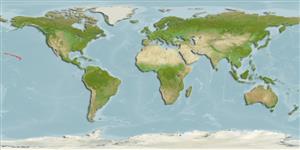Environment: milieu / climate zone / depth range / distribution range
Ekologi
laut berasosiasi dengan karang; nir-ruaya; kisaran kedalaman 6 - 161 m (Ref. 58302). Tropical; 30°N - 15°N
Eastern Pacific: endemic to the Hawaiian Islands. Have recently been reported from Midway Islands (Ref. 28620).
Size / Weight / umur
Maturity: Lm ? range ? - ? cm
Max length : 15.0 cm SL jantan/; (Ref. 7247)
Duri punggung (Keseluruhan (total)): 14; duri punggung lunak (Keseluruhan (total)): 11-13; Duri dubur 2; Sirip dubur lunak: 12 - 13
Benthopelagic (Ref. 58302). Collected from depths of 6 to 46 m. Sexual maturity at about 12.7 cm. Spawning period occur from February through May. Diet consists mainly of calanoid and cyclopoid copepods, but tunicates, mysids, euphausiids, crustacean larvae, larval polychaetes, siphonophores, and fish eggs are also taken (Ref. 7247). Oviparous, distinct pairing during breeding (Ref. 205). Eggs are demersal and adhere to the substrate (Ref. 205). Males guard and aerate the eggs (Ref. 205).
Life cycle and mating behavior
Kematangan | Reproduksi, perkembang biakan | Pemijahan | telur-telur | Fecundity | Larva
Oviparous, distinct pairing during breeding (Ref. 205). Eggs are demersal and adhere to the substrate (Ref. 205). Males guard and aerate the eggs (Ref. 205).
Allen, G.R., 1991. Damselfishes of the world. Mergus Publishers, Melle, Germany. 271 p. (Ref. 7247)
Status IUCN Red List (Ref. 130435)
ancaman kepada manusia
Harmless
penggunaan manusia
Akuarium: Komersial
informasi lanjut
AcuanBudidaya airprofil budidaya airStrainGenetikaElectrophoresesDiturunkanPenyakit-penyakitPengolahanNutrientsMass conversion
mitraGambarStamps, Coins Misc.Suara-suaraCiguateraKecepatanTipe renangArea insangOtolithsOtakPenglihatan / visi
Alat, peralatan
laporan khas
muat turun XML
Sumber internet
Estimates based on models
Preferred temperature (Ref.
123201): 9 - 20.8, mean 14.6 °C (based on 14 cells).
Phylogenetic diversity index (Ref.
82804): PD
50 = 0.5000 [Uniqueness, from 0.5 = low to 2.0 = high].
Bayesian length-weight: a=0.01259 (0.00579 - 0.02736), b=3.03 (2.84 - 3.22), in cm total length, based on LWR estimates for this (Sub)family-body shape (Ref.
93245).
Trophic level (Ref.
69278): 3.1 ±0.0 se; based on diet studies.
Daya lenting (Ref.
120179): sedang, Waktu penggandaan populasi minimum 1.4 - 4.4 tahun (Preliminary K or Fecundity.).
Fishing Vulnerability (Ref.
59153): Low vulnerability (10 of 100).
Nutrients (Ref.
124155): Calcium = 78.7 [45.4, 127.6] mg/100g; Iron = 0.773 [0.484, 1.222] mg/100g; Protein = 18.5 [17.4, 19.5] %; Omega3 = 0.17 [0.11, 0.26] g/100g; Selenium = 31.3 [17.1, 57.5] μg/100g; VitaminA = 203 [73, 563] μg/100g; Zinc = 1.54 [1.07, 2.13] mg/100g (wet weight);
